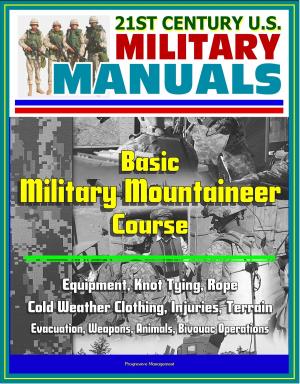21st Century U.S. Military Manuals: Physical Fitness Training FM 21-20 - Exercise, Conditioning, Muscle Groups (Value-Added Professional Format Series)
Nonfiction, Health & Well Being, Fitness, Exercise, Health| Author: | Progressive Management | ISBN: | 9781465830579 |
| Publisher: | Progressive Management | Publication: | September 6, 2011 |
| Imprint: | Smashwords Edition | Language: | English |
| Author: | Progressive Management |
| ISBN: | 9781465830579 |
| Publisher: | Progressive Management |
| Publication: | September 6, 2011 |
| Imprint: | Smashwords Edition |
| Language: | English |
Professionally converted for accurate flowing-text e-book format reproduction, the Physical Fitness Training Field Manual (FM 21-20) covers physical fitness and exercise in the military.
The preface states: "On 5 July 1950, U.S. troops, who were unprepared for the physical demands of war, were sent to battle. The early days of the Korean war were nothing short of disastrous, as U.S. soldiers were routed by a poorly equipped, but well-trained, North Korean People's Army. As American soldiers withdrew, they left behind wounded comrades and valuable equipment their training had not adequately prepared them to carry heavy loads. The costly lessons learned by Task Force Smith in Korea are as important today as ever. If we fail to prepare our soldiers for their physically demanding wartime tasks, we are guilty of paying lip service to the principle of "Train as you fight." Our physical training programs must do more for our soldiers than just get them ready for the semiannual Army Physical Fitness Test (APFT). FM 21 -20 is directed at leaders who plan and conduct physical fitness training. It provides guidelines for developing programs which will improve and maintain physical fitness levels for all Army personnel. These programs will help leaders prepare their soldiers to meet the physical demands of war. This manual can also be used as a source book by all soldiers. The benefits to be derived from a good physical fitness program are many. It can reduce the number of soldiers on profile and sick call, invigorate training, and enhance productivity and mental alertness. A good physical fitness program also promotes team cohesion and combat survivability. It will improve soldiers' combat readiness."
Contents include:
* Cardiorespiratory Fitness
* Muscular Endurance and Strength
* Beginning Exercise Program (exercise descriptions)
* Advanced Exercise Program (exercise descriptions)
* Flexibility
* Body Composition
* Nutrition and Fitness
* Circuit Training and Exercise Drills
* Obstacle Courses and Additional Drills
* Competitive Fitness Activities
* Physical Training during Initial Entry Training
* Environmental Considerations
* Injuries
* Army Physical Fitness Test
* Selecting the Right Running Shoe
As a bonus, this reproduction includes FM-1, The Army Field Manual, a capstone manual containing the vision for the Army - sold separately for $5.99. FM 1 establishes the fundamental principles for employing Landpower. The most important of these are the Army's operational concept and the fundamentals that support it. They form the foundation for all Army doctrine. All Soldiers should understand and internalize them. FM 1 describes the American profession of arms, the Army's place in it, and what it means to be a professional Soldier.
This is a privately authored news service and educational publication of Progressive Management.
Professionally converted for accurate flowing-text e-book format reproduction, the Physical Fitness Training Field Manual (FM 21-20) covers physical fitness and exercise in the military.
The preface states: "On 5 July 1950, U.S. troops, who were unprepared for the physical demands of war, were sent to battle. The early days of the Korean war were nothing short of disastrous, as U.S. soldiers were routed by a poorly equipped, but well-trained, North Korean People's Army. As American soldiers withdrew, they left behind wounded comrades and valuable equipment their training had not adequately prepared them to carry heavy loads. The costly lessons learned by Task Force Smith in Korea are as important today as ever. If we fail to prepare our soldiers for their physically demanding wartime tasks, we are guilty of paying lip service to the principle of "Train as you fight." Our physical training programs must do more for our soldiers than just get them ready for the semiannual Army Physical Fitness Test (APFT). FM 21 -20 is directed at leaders who plan and conduct physical fitness training. It provides guidelines for developing programs which will improve and maintain physical fitness levels for all Army personnel. These programs will help leaders prepare their soldiers to meet the physical demands of war. This manual can also be used as a source book by all soldiers. The benefits to be derived from a good physical fitness program are many. It can reduce the number of soldiers on profile and sick call, invigorate training, and enhance productivity and mental alertness. A good physical fitness program also promotes team cohesion and combat survivability. It will improve soldiers' combat readiness."
Contents include:
* Cardiorespiratory Fitness
* Muscular Endurance and Strength
* Beginning Exercise Program (exercise descriptions)
* Advanced Exercise Program (exercise descriptions)
* Flexibility
* Body Composition
* Nutrition and Fitness
* Circuit Training and Exercise Drills
* Obstacle Courses and Additional Drills
* Competitive Fitness Activities
* Physical Training during Initial Entry Training
* Environmental Considerations
* Injuries
* Army Physical Fitness Test
* Selecting the Right Running Shoe
As a bonus, this reproduction includes FM-1, The Army Field Manual, a capstone manual containing the vision for the Army - sold separately for $5.99. FM 1 establishes the fundamental principles for employing Landpower. The most important of these are the Army's operational concept and the fundamentals that support it. They form the foundation for all Army doctrine. All Soldiers should understand and internalize them. FM 1 describes the American profession of arms, the Army's place in it, and what it means to be a professional Soldier.
This is a privately authored news service and educational publication of Progressive Management.















